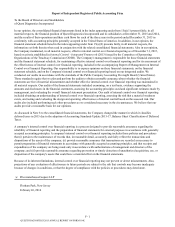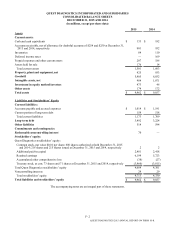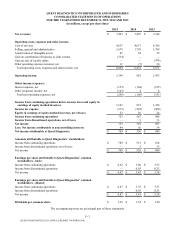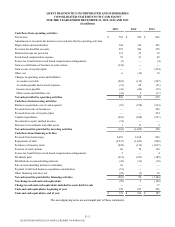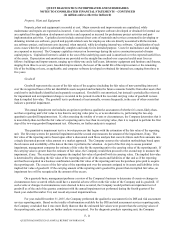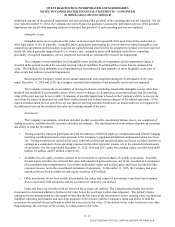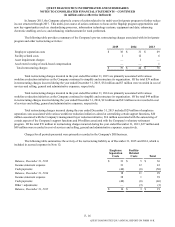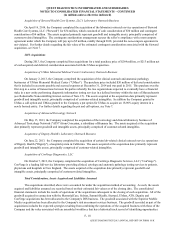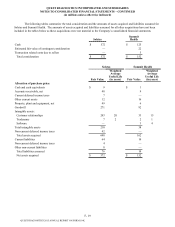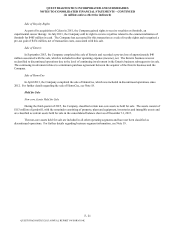Quest Diagnostics 2015 Annual Report Download - page 86
Download and view the complete annual report
Please find page 86 of the 2015 Quest Diagnostics annual report below. You can navigate through the pages in the report by either clicking on the pages listed below, or by using the keyword search tool below to find specific information within the annual report.QUEST DIAGNOSTICS INCORPORATED AND SUBSIDIARIES
NOTES TO CONSOLIDATED FINANCIAL STATEMENTS – CONTINUED
(in millions unless otherwise indicated)
F- 11
Property, Plant and Equipment
Property, plant and equipment is recorded at cost. Major renewals and improvements are capitalized, while
maintenance and repairs are expensed as incurred. Costs incurred for computer software developed or obtained for internal use
are capitalized for application development activities and expensed as incurred for preliminary project activities and post-
implementation activities. Capitalized costs include external direct costs of materials and services consumed in developing or
obtaining internal-use software, payroll and payroll-related costs for employees who are directly associated with the internal-
use software project, and interest costs incurred, when material, while developing internal-use software. Capitalization of such
costs ceases when the project is substantially complete and ready for its intended purpose. Costs for maintenance and training
are expensed as incurred. The Company capitalizes interest on borrowings during the active construction period of major
capital projects. Capitalized interest is added to the cost of the underlying assets and is amortized over the expected useful lives
of the assets. Depreciation and amortization are provided on the straight-line method over expected useful asset lives as
follows: buildings and improvements, ranging up to thirty-one and a half years; laboratory equipment and furniture and fixtures,
ranging from three to seven years; leasehold improvements, the lesser of the useful life of the improvement or the remaining
life of the building or lease, as applicable; and computer software developed or obtained for internal use, ranging from three to
five years.
Goodwill
Goodwill represents the excess of the fair value of the acquiree (including the fair value of non-controlling interests)
over the recognized bases of the net identifiable assets acquired and includes the future economic benefits from other assets that
could not be individually identified and separately recognized. Goodwill is not amortized, but instead is periodically reviewed
for impairment and an impairment charge is recorded in the periods in which the recorded carrying value of goodwill is more
than its implied fair value. The goodwill test is performed at least annually, or more frequently, in the case of other events that
indicate a potential impairment.
The annual impairment test includes an option to perform a qualitative assessment of whether it is more-likely-than-
not that a reporting unit's fair value is less than its carrying value prior to, or as an alternative to, performing the two-step
quantitative goodwill impairment test. If, after assessing the totality of events or circumstances, the Company determines that it
is more-likely-than-not that the fair value of a reporting unit is less than its carrying value, then it is required to perform the first
step of the two-step goodwill impairment test. Otherwise, no further analysis is required.
The quantitative impairment test is a two-step process that begins with the estimation of the fair value of the reporting
unit. The first step screens for potential impairment and the second step measures the amount of the impairment, if any. The
fair value of the reporting unit is based upon either a discounted cash flows analysis that converts future cash flow amounts into
a single discounted present value amount or a market approach. The Company assesses the valuation methodology based upon
the relevance and availability of the data at the time it performs the valuation. As part of the first step to assess potential
impairment, management compares the estimate of fair value for the reporting unit to the carrying value of the reporting unit. If
the carrying value is greater than the estimate of fair value, the Company would then proceed to the second step to measure the
impairment, if any. The second step compares the implied fair value of goodwill with its carrying value. The implied fair value
is determined by allocating the fair value of the reporting unit to all of the assets and liabilities of that unit as if the reporting
unit had been acquired in a business combination and the fair value of the reporting unit was the purchase price paid to acquire
the reporting unit. The excess of the fair value of the reporting unit over the amounts assigned to its assets and liabilities is the
implied fair value of goodwill. If the carrying amount of the reporting unit's goodwill is greater than its implied fair value, an
impairment loss will be recognized in the amount of the excess.
On a quarterly basis, management performs a review of the Company's business to determine if events or changes in
circumstances have occurred which could have a material adverse effect on the fair value of the Company and its goodwill. If
such events or changes in circumstances were deemed to have occurred, the Company would perform an impairment test of
goodwill as of the end of the quarter, consistent with the annual impairment test performed during the fourth quarter of the
fiscal year ended December 31st, and record any noted impairment loss.
For year ended December 31, 2015, the Company performed the qualitative assessment for its DIS and risk assessment
services reporting units. Based on the totality of information available for the DIS and risk assessment services reporting units,
the Company concluded that it was more likely than not that the estimated fair values were greater than the carrying values of
the reporting units, and as such, no further analysis was required. For the diagnostic products reporting unit, the Company
QUEST DIAGNOSTICS 2015 ANNUAL REPORT ON FORM 10-K


